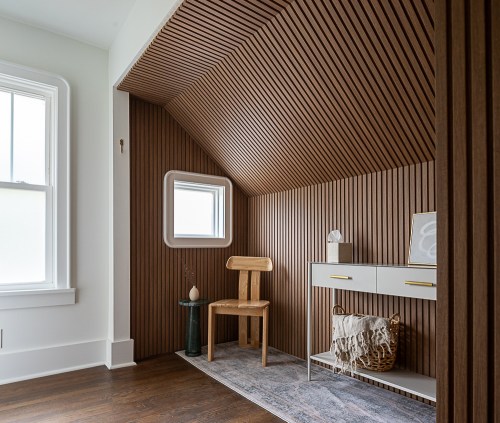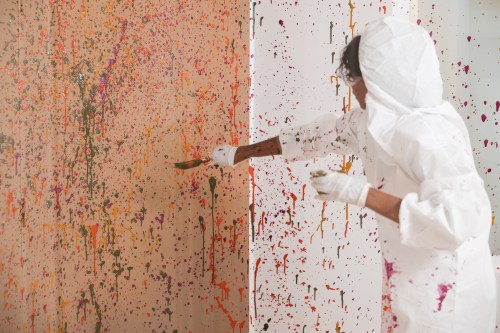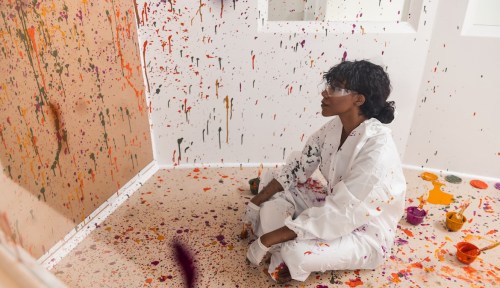On a recent afternoon in Nashville, I drove to an unassuming house in the middle of Music Row. It’s a popular street that’s home to country music legends. You’ll find tons of music references and folklore, from the studios where Elvis put down his famous tracks, to where Dolly Parton recorded her iconic song “Jolene.” This history is so thick, you’d think it was woven into the humidity that hangs in the air—like a song you can’t get out of your head.
Experts in This Article
board-certified art therapist and founder of Creative Insight Mental Wellness
art therapist, founder, and director of The Center of Creativity and Healing in Charlotte, North Carolina
But I wasn’t searching for a venue or record label. I was looking for a studio that had nothing to do with music.
My goal was to find Therapaint—a newly opened paint throwing studio in the heart of Music City, founded by Jackie Laurian. I’d been invited to try out their experience, which is essentially, flinging paint in the name of stress reduction. Not only was I intrigued, but at the time, I was very, very stressed. Call it the “millennial condition.” Call it watching my elderly parents deteriorate at a breathtaking pace. Call it whatever you want, but almost every morning last summer I’d woken up in a low-boiling panic.
I wracked my brain (alone and with my therapist) over what could be the culprit. Maybe it was the relentless heat in Nashville, or that I missed my friends back in New York—where I’d lived previously for over a decade. Maybe it was something I hadn’t even thought of. While I never pinpointed it to a single source, I recognized that I needed to reach beyond my usual tools to assuage my anxiety.
Similar stressful experiences led Laurian to open Therapaint. Navigating her husband’s ongoing health issues and caring for their young children, Laurian began to drown in overwhelm. “I just remember feeling like I’m holding so much, I’m carrying so much, I need to get this feeling out of me, but talking doesn’t reach it,” she recalls. That’s when the seed of Therapaint began to take root, though it would take years of throwing paint, inviting friends to do the same, and finding the optimal location, before her studio was finished and open.
Needless to say, when my invitation to throw paint reached my inbox, I was all in. And I was curious: Could throwing paint against a wall really help my simmering anxiety? I was about to find out.
My experience at a splatter paint studio
When I arrived on the day of my session, I went on a brief tour. The studio is a beautifully updated bungalow that, honestly, I wish I could move into. It’s got an adorable waiting room, cozy meditation nook, bright and private paint-flinging studios, and a back garden. Then it was time for the session.


I started by choosing four non-toxic paints, which Laurian set up for me in an upstairs studio. One side of the studio space had a long roll of paper and the other had a place to drop my stuff and change into protective paint gear. The space was well-lit without being harsh, and open, like a well-intentioned invitation. In no time, Laurian quietly closed the door behind her, and I was free to wreak havoc on some poor, unassuming paper.
As I opened the first canister of paint, the scent brought me back to childhood summers spent in my house’s basement where my mother taught art classes. Fling. The color blue reminded me of the ocean at night. Thwack. The chaos of dripping paint resembled the cartography of wrinkles on tear-stained pillows. Thwop. I went on until no longer cognizant of the memories or words my brain attempted to assign to my actions—a biggie for someone who writes for a living. I smeared, spilled, and tossed until I had tunnel vision of the paint, the splattered paper and walls, and the stress uncoiling from my shoulders.
I looked at the timer. Five minutes had passed. That’s when I decided to have fun. I wanted to purge the anxiety that brought me to Therapaint, but also replace it with something else: hope. Forty-ish minutes later, I walked out of the studio a little dazed and…settled. Laurian greeted me with a knowing smile.
Unsurprisingly, I’m not the only one who’s found a reprieve in the paint. “We have seen people come in to celebrate their thirtieth birthday with their partner, to people struggling with a bad cancer diagnosis. People are coming in with grief and loss. People are coming in with regular, everyday stress: too much laundry, not enough sleep. It’s everything across the board,” says Laurian.

What’s the difference between paint throwing and art therapy?
With such a swath of visitors, I wondered if paint throwing, specifically in this serene sort of environment, could be considered a form of art therapy. “Art therapy is a unique, psychotherapeutic approach facilitated by licensed, master’s-level clinicians trained in both psychotherapy and art,” explains Cheryl Walpole Tiku, LPC, LCAT, ATR-BC, a board-certified art therapist and founder of Creative Insight Mental Wellness.
“It’s not about interpreting your artwork or being an artist—it’s about using the creative process to express thoughts and emotions that might be difficult to verbalize. Open to all ages, art therapy is practiced in various settings including hospitals, schools, clinics, and private practices, offering a safe space for healing and self-exploration. It’s about the process, not the final piece of art,” says Tiku.
While paint throwing may carry whiffs of art therapy, experts say it’s not the same thing. For one, a paint throwing session isn’t typically supervised by a licensed professional. Plus, an art therapist generally helps to kick off, guide, and then process the art creation with their client.
“Typically, [in an art therapy session] there is an invitation to process,” says Maria Curran, MEd, PhD, LCMHCS, art therapist, founder, and director of The Center of Creativity and Healing in Charlotte, North Carolina. “If I’m doing an individual session, I’m absolutely going to process with a client.” This involves the client responding to open-ended questions posed by the therapist, she adds.
That being said, art therapists may use paint throwing as a modality in their sessions. “I look at something like paint throwing as ‘art as therapy,’ or therapeutic art making, just as any creative outlet could provide,” says Tiku. “When used in an art therapy session, paint throwing would have to be an appropriate intervention for that particular client.”
Where a visit to a paint throwing studio only offers one type of experience, an art therapist may have scores of techniques or types of art at their fingertips for a client, which all depends on the client’s needs and the therapist’s focus for the session.
This is not to say you can’t try paint throwing on your own for anxiety. (More on this below.)
Can paint throwing help anxiety?
Paint throwing can provide a positive release, like venturing out on a hike or trying a new recipe. While there’s not much research on the efficacy of paint throwing for anxiety, there is some research to show that art therapy can help treat mental health issues from anxiety to schizophrenia to dementia, per an August 2022 critical review in Cureus.
For stress, specifically, art therapy has been shown to reduce high cortisol levels in adults. In fact, a small 2016 study conducted by the National Arts Program (and published in Science Daily) found that cortisol levels dropped in 75 percent of adult participants after 45 minutes of making art. Where paint throwing fits in, though, depends greatly on the client and clinician.
More research is needed, but broadly speaking, both Tiku and Curran say paint throwing could be useful—but maybe not in the ways you think. Mainly, it helps tap into healing your inner child. “Finding ways to express yourself, spend time with others, and connect to a time when getting messy was easy and okay [in childhood], can potentially be fostered by attending a paint throwing studio,” says Tiku. “Doing something new and different can be inspirational and perhaps a release of tension and stress. Adults need to find time to play, it’s not just for kids.”
“Doing something new and different can be inspirational and perhaps a release of tension and stress. Adults need to find time to play, it’s not just for kids.”—Cheryl Walpole Tiku, certified art therapist
Curran agrees: “Places like these splatter paint studios are a nice entry into being creative because most of us as kids loved art and loved music,” she says. “We would dance spontaneously, and role-play, and do all these fun things. For me, making art is a way to play as an adult, and I think that that’s important for us.”
Both Laurian and Curran also mention paint throwing can help people overcome the mindset that “they’re not artists.” At Therapoint, visitors aren’t allowed to bring their final product home with them—it’s composted and then used as fertilizer for their back garden. “[It’s] something beautiful coming from something difficult,” Laurian says.
When to see a therapist for anxiety
Visiting a paint throwing studio can offer a safe environment to reconnect with yourself while using creativity to process. But be sure to keep your expectations—and needs—in check.
“If you’re really struggling with something interpersonally, I don’t think that a paint throwing experience should be a substitute for working with a qualified clinician who is going to offer more guidance, feedback, and help,” says Curran. “But I think if you’re looking for something that is fun, expressive, and helps you get out of your normal routine, and if you want to do something that’s creative, I’m a huge proponent of it.”
But if you’re searching for something specialized, or if you’re dealing with something challenging, Tiku emphasizes the importance of seeing a licensed therapist for help. “[Paint throwing studios] are great for your overall well-being and connection, but it’s not therapy. Art therapy can only be conducted with a licensed and trained professional,” she says.
Laurian doesn’t claim that Therapaint is a replacement for art therapy, either. In fact, she says that she regularly works with licensed therapists of all stripes to provide a network of support for their clients. “We partner with a lot of different therapists, not just art therapists,” says Laurian, continuing to say that therapists might refer clients to Therapaint as an extension of the therapy, for “someone who might need a physical experience or a visual representation,” but not a stand-in.
How to find a paint throwing studio near you
If you’ve read this far and have wondered, “Where can I do this?”, you may be in luck. Paint throwing studios are becoming more and more popular, so the best place to start looking might be by doing a quick Google search for splatter paint or paint throwing studios in your area. You may also have some luck searching on Instagram or TikTok for local businesses. Lastly, if you’re seeing an art therapist (or therapist in general), asking them for recommendations could be helpful.
A therapist may be able to point you in the direction of a studio that offers a quiet, healing, and private atmosphere, like Therapaint. Other venues may offer more of a happy hour or group activity experience (which is also totally cool if that’s your vibe!). Ultimately, the right paint studio will depend on what you’re looking for out of the session.
I, for one, can’t wait to go back and relieve some stress.
Sign Up for Our Daily Newsletter
Get all the latest in wellness, trends, food, fitness, beauty, and more delivered right to your inbox.
Got it, you've been added to our email list.











